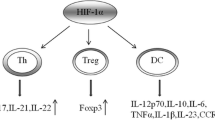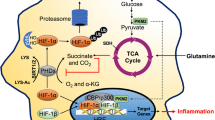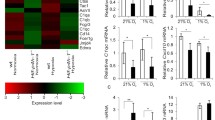Abstract
Hypoxia-inducible factor 1 (HIF-1) is a heterodimeric transcription complex which plays a crucial role in cellular adaptation to low oxygen availability. In the last years there has been increasing evidence about the role of this factor in inflammatory/innate immune reactions. It has also been found to contribute to different types of allergic inflammation. In this review the current knowledge about the accumulation and role of HIF-1 in Toll-like receptor-mediated and allergic inflammation is summarized. Differential biochemical mechanisms employed to stabilize the protein in different cases are discussed.

Similar content being viewed by others
References
Akira S, Takeda K (2004) Toll-like receptor signalling. Nat Rev Immunol 4:499–511
Beutler B (2004) Inferences, questions and possibilities in Toll-like receptor signalling. Nature 430:257–263
Blouin CC, Page EL, Soucy GM et al (2004) Hypoxic gene activation by lipopolysaccharide in macrophages: implication of hypoxia-inducible factor 1alpha. Blood 103:1124–1130
Cramer T, Yamanishi Y, Clausen BE et al (2003) HIF-1alpha is essential for myeloid cell-mediated inflammation. Cell 112:645–657
Crivellato E, Travan L, Ribatti D (2009) Mast cells and basophils: a potential link in promoting angiogenesis during allergic inflammation. Int Arch Allergy Immunol 151:89–97
Dehne N, Brune B (2009) HIF-1 in the inflammatory microenvironment. Exp Cell Res 315:1791–1797
Djafarzadeh S, Spirig R, Regueira T et al (2008) Induction of hypoxia inducible factor 1α by Toll-like receptors in human dendritic cells. Crit Care 12:S1–S151
Epstein AC, Gleadle JM, McNeill LA et al (2001) C. elegans EGL-9 and mammalian homologs define a family of dioxygenases that regulate HIF by prolyl hydroxylation. Cell 107:43–54
Falcone FH, Haas H, Gibbs BF (2000) The human basophil: a new appreciation of its role in immune responses. Blood 96:4028–4038
Frede S, Stockmann C, Freitag P et al (2006) Bacterial lipopolysaccharide induces HIF-1 activation in human monocytes via p44/42 MAPK and NF-kappaB. Biochem J 396:517–527
Galli SJ, Grimbaldeston M, Tsai M (2008) Immunomodulatory mast cells: negative, as well as positive, regulators of immunity. Nat Rev Immunol 8:478–486
Garlanda C, Anders HJ, Mantovani A (2009) TIR8/SIGIRR: an IL-1R/TLR family member with regulatory functions in inflammation and T cell polarization. Trends Immunol 30:439–446
Gay NJ, Gangloff M (2007) Structure and function of Toll receptors and their ligands. Annu Rev Biochem 76:141–165
Gould HJ, Sutton BJ, Beavil AJ et al (2003) The biology of IGE and the basis of allergic disease. Annu Rev Immunol 21:579–628
Gray P, Dunne A, Brikos C et al (2006) MyD88 adapter-like (Mal) is phosphorylated by Bruton’s tyrosine kinase during TLR2 and TLR4 signal transduction. J Biol Chem 281:10489–10495
Grimbaldeston MA, Metz M, Yu M et al (2006) Effector and potential immunoregulatory roles of mast cells in IgE-associated acquired immune responses. Curr Opin Immunol 18:751–760
Hayakawa T, Matsuzawa A, Noguchi T et al (2006) The ASK1-MAP kinase pathways in immune and stress responses. Microbes Infect 8:1098–1107
He H, Genovese KJ, Nisbet DJ et al (2006) Involvement of phosphatidylinositol-phospholipase C in immune response to Salmonella lipopolysacharide in chicken macrophage cells (HD11). Int Immunopharmacol 6:1780–1787
Huang LE, Gu J, Schau M et al (1998) Regulation of hypoxia-inducible factor 1alpha is mediated by an O2-dependent degradation domain via the ubiquitin-proteasome pathway. Proc Natl Acad Sci USA 95:7987–7992
Ivan M, Kondo K, Yang H et al (2001) HIFalpha targeted for VHL-mediated destruction by proline hydroxylation: implications for O2 sensing. Science 292:464–468
Iwasaki A, Medzhitov R (2004) Toll-like receptor control of the adaptive immune responses. Nat Immunol 5:987–995
Jaakkola P, Mole DR, Tian YM et al (2001) Targeting of HIF-alpha to the von Hippel-Lindau ubiquitylation complex by O2-regulated prolyl hydroxylation. Science 292:468–472
Jantsch J, Chakravortty D, Turza N et al (2008) Hypoxia and hypoxia-inducible factor-1 alpha modulate lipopolysaccharide-induced dendritic cell activation and function. J Immunol 180:4697–4705
Jelkmann Y (2004) Molecular biology of erythropoietin. Int Med 43:649–659
Jung YJ, Isaacs JS, Lee S et al (2003) IL-1beta-mediated up-regulation of HIF-1alpha via an NFkappaB/COX-2 pathway identifies HIF-1 as a critical link between inflammation and oncogenesis. FASEB J 17:2115–2117
Kim AH, Khursigara G, Sun X et al (2001) Akt phosphorylates and negatively regulates apoptosis signal-regulating kinase 1. Mol Cell Biol 21:893–901
Koff JL, Shao MX, Kim S et al (2006) Pseudomonas lipopolysaccharide accelerates wound repair via activation of a novel epithelial cell signaling cascade. J Immunol 177:8693–8700
Kuhlicke J, Frick JS, Morote-Garcia JC et al (2007) Hypoxia inducible factor (HIF)-1 coordinates induction of Toll-like receptors TLR2 and TLR6 during hypoxia. PLoS One 2:e1364
Kwon SJ, Song JJ, Lee YJ (2005) Signal pathway of hypoxia-inducible factor-1alpha phosphorylation and its interaction with von Hippel-Lindau tumor suppressor protein during ischemia in MiaPaCa-2 pancreatic cancer cells. Clin Cancer Res 11:7607–7613
Lall H, Coughlan K, Sumbayev VV (2008) HIF-1alpha protein is an essential factor for protection of myeloid cells against LPS-induced depletion of ATP and apoptosis that supports Toll-like receptor 4-mediated production of IL-6. Mol Immunol 45:3045–3049
Lee KS, Kim SR, Park SJ et al (2008) Mast cells can mediate vascular permeability through regulation of the PI3K-HIF-1alpha-VEGF axis. Am J Respir Crit Care Med 178:787–797
Matsuzawa A, Saegusa K, Noguchi T et al (2005) ROS-dependent activation of the TRAF6-ASK1–p38 pathway is selectively required for TLR4-mediated innate immunity. Nat Immunol 6:587–592
Maxwell PH, Wiesener MS, Chang GW et al (1999) The tumour suppressor protein VHL targets hypoxia-inducible factors for oxygen-dependent proteolysis. Nature 399:271–275
Medzhitov R, Janeway C Jr (2000) Innate immunity. N Engl J Med 343:338–344
Medzhitov R, Preston-Hurlburt P, Janeway CA Jr (1997) A human homologue of the Drosophila Toll protein signals activation of adaptive immunity. Nature 388:394–397
Min B, Paul WE (2008) Basophils and type 2 immunity. Curr Opin Hematol 15:59–63
Min B, Prout M, Hu-Li J et al (2004) Basophils produce IL-4 and accumulate in tissues after infection with a Th2-inducing parasite. J Exp Med 200:507–517
Mylonis I, Chachami G, Samiotaki M et al (2006) Identification of MAPK phosphorylation sites and their role in the localization and activity of hypoxia-inducible factor-1alpha. J Biol Chem 281:33095–33106
Nicholas SA, Sumbayev VV (2009) The involvement of hypoxia-inducible factor 1 alpha in Toll-like receptor 7/8-mediated inflammatory response. Cell Res 19:973–983
Nicholas SA, Sumbayev VV (2010) The role of redox-dependent mechanisms in the downregulation of ligand-induced Toll-like receptors 7, 8 and 4-mediated HIF-1alpha prolyl hydroxylation. Immunol Cell Biol 88:180–186
Nishi K, Oda T, Takabuchi S et al (2008) LPS induces hypoxia-inducible factor 1 activation in macrophage-differentiated cells in a reactive oxygen species-dependent manner. Antioxid Redox Signal 10:983–995
Oda T, Hirota K, Nishi K et al (2006) Activation of hypoxia-inducible factor 1 during macrophage differentiation. Am J Physiol Cell Physiol 291:C104–C113
Oh YT, Lee JY, Yoon H et al (2008) Lipopolysaccharide induces hypoxia-inducible factor-1 alpha mRNA expression and activation via NADPH oxidase and Sp1-dependent pathway in BV2 murine microglial cells. Neurosci Lett 431:155–160
Pacquelet S, Johnson JL, Ellis BA et al (2007) Cross-talk between IRAK-4 and the NADPH oxidase. Biochem J 403:451–461
Park HS, Yu JW, Cho JH et al (2004) Inhibition of apoptosis signal-regulating kinase 1 by nitric oxide through a thiol redox mechanism. J Biol Chem 279:7584–7590
Peyssonnaux C, Datta V, Cramer T et al (2005) HIF-1a expression regulates the bacterial capacity of phagocytes. J Clin Invest 115:1806–1815
Peyssonnaux C, Cejudo-Martin P, Doedens A et al (2007) Cutting edge: essential role of hypoxia inducible factor-1alpha in development of lipopolysaccharide-induced sepsis. J Immunol 178:7516–7519
Prabhakar NR, Kumar GK, Nanduri J (2009) Intermittent hypoxia-mediated plasticity of acute O2 sensing requires altered Red-Ox regulation by HIF-1 and HIF-2. Ann NY Acad Sci 1117:162–168
Prussin C, Metcalfe DD (2003) 4. IgE, mast cells, basophils, and eosinophils. J Allergy Clin Immunol 111(2 suppl):S486–S494
Schroeder JT, MacGlashan DW Jr, Lichtenstein LM (2001) Human basophils: mediator release and cytokine production. Adv Immunol 77:93–122
Schwartzberg PL (2003) Amplifying Btk’s signal. Immunity 19:634–636
Semenza GL (2002) HIF-1 and tumor progression: pathophysiology and therapeutics. Trends Mol Med 8(4 suppl):S62–S67
Siow YL, Au-Yeung KK, Woo CW et al (2006) Homocysteine stimulates phosphorylation of NADPH oxidase p47phox and p67phox subunits in monocytes via protein kinase Cbeta activation. Biochem J 398:73–82
Sumbayev VV (2008a) LPS-induced Toll-like receptor 4 signalling triggers cross-talk of apoptosis signal-regulating kinase 1 (ASK1) and HIF-1alpha protein. FEBS Lett 582:319–326
Sumbayev VV (2008b) PI3 kinase and direct S-nitrosation are involved in down-regulation of apoptosis signal-regulating kinase 1 during LPS-induced Toll-like receptor 4 signalling. Immunol Lett 115:126–130
Sumbayev VV, Yasinska IM (2006) Role of MAP kinase-dependent apoptotic pathway in innate immune responses and viral infection. Scand J Immunol 63:391–400
Sumbayev VV, Yasinska IM (2007) Mechanisms of hypoxic signal transduction regulated by reactive nitrogen species. Scand J Immunol 65:399–406
Sumbayev VV, Budde A, Zhou J et al (2003) HIF-1 alpha protein as a target for S-nitrosation. FEBS Lett 535:106–112
Sumbayev VV, Nicholas SA, Streatfield CL et al (2009) Involvement of hypoxia-inducible factor-1 in IgE-mediated primary human basophil responses. Eur J Immunol 39:3511–3519
Viemann D, Schmidt M, Tenbrock K et al (2007) The contact allergen nickel triggers a unique inflammatory and proangiogenic gene expression pattern via activation of NF-kappaB and hypoxia-inducible factor-1alpha. J Immunol 178:3198–3207
Walmsley SR, Cadwallader KA, Chilvers ER (2005) The role of HIF-1alpha in myeloid cell inflammation. Trends Immunol 26:434–439
Yarovinsky F, Zhang D, Andersen JF et al (2005) TLR11 activation of dendritic cells by a protozoan profilin-like protein. Science 308:1626–1629
Yasinska IM, Kozhukhar AV, Sumbayev VV (2004) S-nitrosation of thioredoxin in the nitrogen monoxide/superoxide system activates apoptosis signal-regulating kinase 1. Arch Biochem Biophys 428:198–203
Yuan G, Nanduri J, Khan S et al (2008) Induction of HIF-1alpha expression by intermittent hypoxia: involvement of NADPH oxidase, Ca2+ signalling, prolyl hydroxylases, and mTOR. J Cell Physiol 217:674–685
Zarember KA, Malech HL (2005) HIF-1alpha: a master regulator of innate host defenses? J Clin Invest 115:1702–1704
Zhou G, Golden T, Aragon IV et al (2004) Ser/Thr protein phosphatase 5 inactivates hypoxia-induced activation of an apoptosis signal-regulating kinase 1/MKK-4/JNK signaling cascade. J Biol Chem 279:46595–46605
Acknowledgments
We apologize to those researchers whose primary studies that form the basis of our current knowledge in the discussed field could not be cited due to space limitations or were indirectly acknowledged by quoting current reviews. This work was supported by the Royal Society (grant number RG080474 to Dr. V. Sumbayev) and by the start-up grant provided to Dr. Sumbayev by the Medway School of Pharmacy, University of Kent.
Author information
Authors and Affiliations
Corresponding author
About this article
Cite this article
Sumbayev, V.V., Nicholas, S.A. Hypoxia-inducible Factor 1 as one of the “Signaling Drivers” of Toll-like Receptor-Dependent and Allergic Inflammation. Arch. Immunol. Ther. Exp. 58, 287–294 (2010). https://doi.org/10.1007/s00005-010-0083-0
Received:
Accepted:
Published:
Issue Date:
DOI: https://doi.org/10.1007/s00005-010-0083-0




